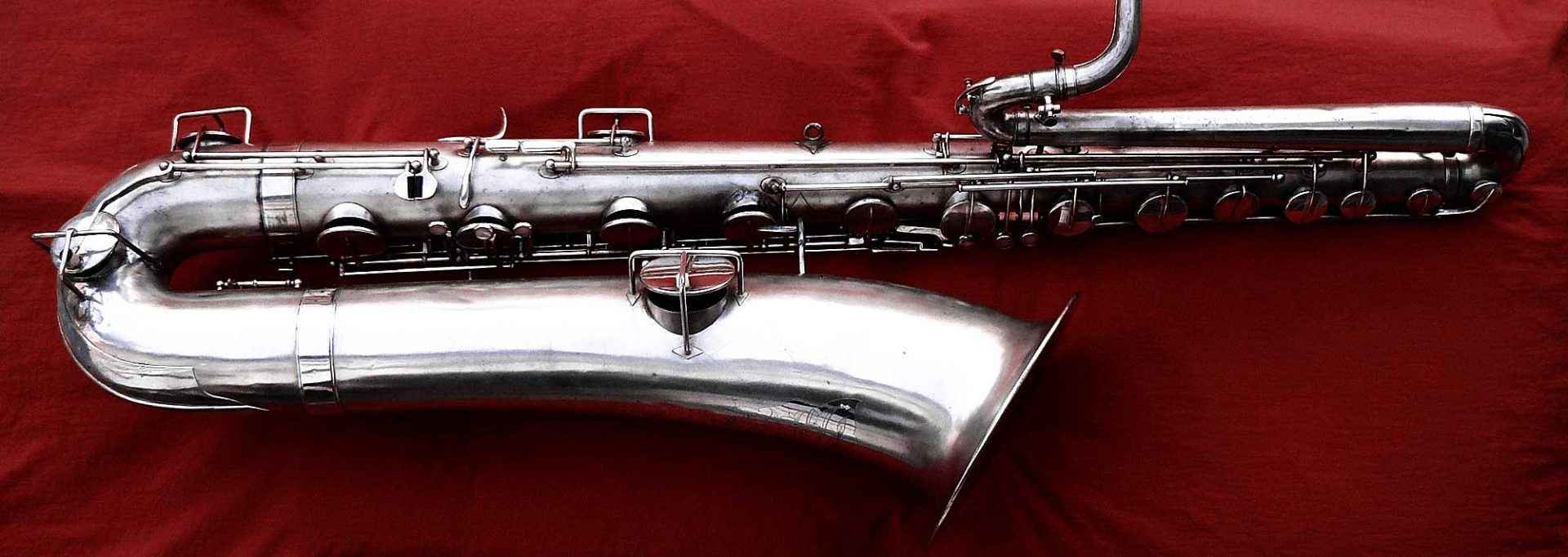A couple of weeks ago I was sent the most amazing treasure trove of vintage sax resources: nearly 400 MB of vintage German catalogue pages containing saxophone listings. As I was pouring through the 381 files that make up this amazing collection of catalogue pages containing (now) vintage saxophones, I noticed something very interesting in the pages of the Jörgensen catalogue. Jörgensen was a music mail order store from Düsseldorf, and as you can see by the cover below, they were a Hohner dealer.
Jörgensen Musikversandhaus: West Germany’s largest mail-order music store.
As this cover states, they were offering the newest Hohner models, as well as all other instruments. Unfortunately there is no date noted anywhere in the catalogue, but based on the Selmer Balanced action tenor illustrated in it, it is pre-1954.
We know the Hohner President started production in 1949, so this catalogue was produced between 1949 – 1953. Comparing the neck and bow guard illustrated on the Hohner President to those illustrated in this vintage brochure, I estimate this catalogue to be circa 1950.
Check out the prices of the Hohner President, and then compare them to the Keilwerth The New King and Toneking. See anything interesting? Yup, your eyes are not playing tricks on you. The Hohner President cost more than The New King. (To make things easier for you, I’ve compiled all the data together below in a chart.)
The Toneking came with a high F# key, which is why it cost a few Deutsch Mark (DM) more than The New King. Since the Hohner President didn’t have a high F# key, it needs to be compared to The New King.
BTW, notice the prices for Selmer BA horns. Even back then the name Selmer meant crazy-high prices.
Getting back to German-made saxophones for a minute, here’s another interesting fact: G.H. Hüller’s Olymp silver-plated model with gold wash bell (the only Hüller this store sold) cost more the JK’s The New King, and only slightly less than Hohner.
Here’s the summary chart of all the alto and tenor prices.
Note: All prices are in Deutsch Mark (DM), which was the German currency at the time.
Alto
President |
The New King |
Toneking |
Olymp |
Balanced Action |
|
Lacquered |
504 |
459 |
513 |
N/A |
972 |
Nickel Plated |
504 |
468 |
522 |
N/A |
N/A |
Silver Plated |
522 |
478 |
531 |
515 |
1030 |
Tenor
President |
The New King |
Toneking |
Olymp |
Balanced Action |
|
Lacquered |
594 |
540 |
599.10 |
N/A |
1161 |
Nickel Plated |
594 |
552 |
618 |
N/A |
N/A |
Silver Plated |
621 |
564 |
633 |
603 |
1228 |
I have said for quite some time that Max Keilwerth’s horns were every bit as good, and in some ways better than, as those built buy his brother Julius. Don’t get me wrong, the Tonekings I have are wonderful instruments, and JK’s are great horns that can hold their own against the competition. But if you take both a JK and a Hohner to your tech, and ask him/her for their assessment, there’s a good chance that your tech will surprise you with their answer.
It’s a simple fact that the Hohner President is not as common a horn as a JK. It’s far more likely your tech has worked on a Toneking or The New King, than on a Hohner. This lack of recognition factor is, I believe, why in North America anyway, the Hohner is significantly undervalued, compared to its JK contemporaries.
What this catalogue from Jörgensen Musikversandhaus tells us.
This catalogue from Jörgensen confirms for me in virtual black and white (colour actually), that right from the outset, Hohner President saxophones were on equal price footing with the other, more well-known, Keilwerth brother’s horns.
Perhaps even more interesting, was that the Olymp by G.H. Hüller was still demanding a lot of coin as well. Don’t forget, after WWII G.H. Hüller found itself on the wrong side of East/West German border, and was in part nationalized in 1947. Many of their horns were sent to the Soviet Union immediately after the war, as part of Germany’s war reparations. In some ways it’s rather surprising that there were any saxes left to sell in West Germany at all.
All a person had to do was order the horn of their dreams from Jörgensen Musikversandhaus, and it would arrive at their door. No fuss. No muss. I wonder what the rates of shipping damage were then, compared to now?
Looking for more background on the saxophones mentioned in the Jörgensen catalogue?
If you’re interested in finding out more about the G.H. Hüller company, I have a page about them on my website. There is also a G.H. Hüller gallery in Bassic Sax Pix, which at last count contained 365 images.
If you’re curious to find out more about Hohner President saxophones, you can read about them on the Hohner page of my site. There is also the President brochure I mentioned earlier. If you haven’t seen it before, it is rather interesting. The Hohner President gallery in Bassic Sax Pix is enormous. At last count it contained over 1800 images.
And finally, speaking of enormous, the Julius Keilwerth gallery on Bassic Sax Pix is crazy-big. Today there are over 5800 images in it, and there are quite a few more that people have sent me that I haven’t even had a chance to upload yet. I also have a number of pages about Julius Keilwerth, his company, and his horns on my website.







